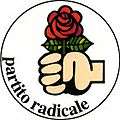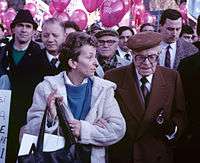Radical Party (Italy)
Radical Party Partito Radicale | |
|---|---|
 | |
| Main leaders |
Marco Pannella for more leaders, see list |
| Founded | 11 December 1955 |
| Dissolved | 1 January 1989 |
| Split from | Italian Liberal Party |
| Merged into |
Pannella List Rainbow Greens |
| Headquarters | via della Torre Argentina 76, Rome |
| Newspaper |
Il Mondo Notizie Radicali |
| Membership (1958) | 11,645 (max)[1] |
| Ideology |
Radicalism[2] Left-libertarianism Social liberalism Anti-clericalism |
| Political position | Centre-left |
| European affiliation | Coordination of European Green and Radical Parties / European Green Coordination (1979–89) |
| International affiliation | none |
| European Parliament group |
Technical Group of Independents (1979–84) Non-Inscrits (1984–89) Green Group (1989) |
| Colours | Orange (informal) |

The Radical Party (Italian: Partito Radicale, PR) was a political party in Italy. For decades it was a bastion of liberalism and radicalism in Italy and proposed itself as the strongest opposition to the Italian political establishment, seen as corrupt and conservative. Although it never reached high shares of vote and never participated in government, the party had close relations with the other parties of the Italian left, from the Republicans and the Socialists to the Communists and Proletarian Democracy, and opened its ranks also to members of other parties, through "double membership".
The party's longtime leader was Marco Pannella (1936–2016), who served as a member of the Chamber of Deputies (1976–1994) and the European Parliament (1979–2009), and led the party in most of the elections it contested.
In 1989 the PR was transformed into the Transnational Radical Party. During the 1990s the Radicals had formed a succession of electoral lists (notably including the Pannella List and Bonino List), without having a structured party and sometimes dividing themselves between competing lists. The current incarnation of the party is the Italian Radicals, founded in 2001.
History
The PR was founded in 1955 by the left-wing of the Italian Liberal Party as the ideal continuation of the historical Radical Party, active from 1877 to 1925, emphasising liberal and secular issues, such as separation of church and state, and the full implementation of the Constitution. Leading members of the new party included Bruno Villabruna, Mario Pannunzio, Ernesto Rossi, Leo Valiani, Guido Calogero, Giovanni Ferrara, Paolo Ungari, Eugenio Scalfari and Marco Pannella.
After a temporary disbandment, the PR was re-founded by Marco Pannella and Gianfranco Spadaccia in 1963 and came to political success in the 1976 general election, when it entered Parliament with 4 deputies: Pannella, Emma Bonino, Adele Faccio and Mauro Mellini. In the 1979 general election the party won 3.5% of the vote and elected 18 deputies and 2 senators, its best result ever. The relative success of the party was a consequence of the new line impressed by Pannella who moved the party's focus to issues like divorce and abortion, also by winning three referenda on those issues in 1974 and 1981.[3] In 1979, following the first European Parliament diect election, the PR was involved with Coordination of European Green and Radical Parties (CEGRP) and its unsuccessful efforts to create a single pan-European platform for green and radical politics.[4]
In the 1980s the party focused more on international and European issues. Pannella was a member of the European Parliament since 1979 and led the party into new battles against hunger and in favour of further European integration. In 1989 the party was transformed into the Transnational Radical Party, an non-governmental organization working at the United Nations and coordinating the efforts of several national parties and groupings mainly in support of human rights.
The Radicals continued to participate in elections through the "Anti-prohibition List on Drugs", the Rainbow Greens, the Pannella List, the Bonino List and the Bonino-Pannella List. In 2001 they re-organised themselves as the Italian Radicals, a full-fledged party, and Bonino served in two governments (Prodi II, 2006–2008, and Letta, 2013–2014). Pannella died, after a long illness, in 2016.
Ideology

The PR gave expression to the transformation of Italian society towards more liberal behaviour and ideas in the post-war period. An anti-clerical party,[5][6] it placed itself in the left-wing, often working for the unity of all the parties of the Italian left (and proposing the adoption of an American-style electoral system based on first-past-the-post voting and the transformation of Italian institutions toward a presidential system), but also often being rejected by certain areas of the left itself, especially those linked with the Italian Communist Party, due to the Radicals' strong belief in libertarian policies, both socially and economically speaking.[6] The party was also known for its strong belief in direct democracy and especially for its promotion of referenda.
In the 1960s the PR launched the Italian League for Divorce (Lega Italiana per il Divorzio, LID), which succeeded in marshalling together the secular parties into a unified political alliance and getting the law on divorce approved. During the 1970s the PR succeeded in starting up the Women's Liberation Movement (Movimento di Liberazione della Donna, MLD), by supporting the activities of the Italian Centre for Sterilisation and Abortion (Centro Italiano Sterilizzazioni e Aborti, CISA) and by giving its support to the Italian Revolutionary Homosexual United Front (Fronte Unitario Omosessuale Rivoluzionario Italiano, FUORI), one of the first Italian homosexual associations. All the afromentioned groups, as well as many others, were part of the Radical movement, that was always organised as a federation of single-issue associations rather than a united party.
Popular support

The PR never gained massive support in elections, due to its loose organisation and eclectic profile. Additionally, the party did not file candidates for all the elections and sometimes even supported abstention from voting. The Radicals' strongest showing was in the 1979 general election, when it obtained 3.5% of the vote and 18 deputies.
Although support for the party was uniform all around the country, the PR did better in the North (especially in Piedmont) and in large cities (Rome, Milan, Turin and Naples) than in the South and in rural areas.[7]
Electoral results
Italian Parliament
| Chamber of Deputies | |||||
| Election year | # of overall votes |
% of overall vote |
# of overall seats won |
+/– | Leader |
|---|---|---|---|---|---|
| 1958 | 405,574 (#9) | 1.37 | 6 / 596 |
|
|
| 1963 | did not run | |
0 / 630 |
|
|
| 1968 | did not run | |
0 / 630 |
|
|
| 1972 | did not run | |
0 / 630 |
|
|
| 1976 | 394,212 (#9) | 1.07 | 4 / 630 |
|
|
| 1979 | 1,264,870 (#6) | 3.45 | 18 / 630 |
|
|
| 1983 | 809,810 (#8) | 2.19 | 11 / 630 |
|
|
| 1987 | 987,720 (#7) | 2.56 | 13 / 630 |
|
|
| Senate | |||||
| Election year | # of overall votes |
% of overall vote |
# of overall seats won |
+/– | Leader |
|---|---|---|---|---|---|
| 1958 | 363,462 (#9) | 1.39 | 0 / 246 |
|
|
| 1963 | did not run | |
0 / 315 |
|
|
| 1968 | did not run | |
0 / 315 |
|
|
| 1972 | did not run | |
0 / 315 |
|
|
| 1976 | 265,947 (#9) | 0.85 | 0 / 315 |
|
|
| 1979 | 413,444 (#6) | 1.32 | 2 / 315 |
|
|
| 1983 | 548,229 (#8) | 1.76 | 1 / 315 |
|
|
| 1987 | 572,461 (#6) | 1.77 | 3 / 315 |
|
|
European Parliament
| European Parliament | ||||||
| Election year | # of overall votes |
% of overall vote |
# of overall seats won |
+/– | Leader | |
|---|---|---|---|---|---|---|
| 1979 | 1,285,065 (#6) | 3.67 | 3 / 81 |
|
| |
| 1984 | 1,199,876 (#7) | 3.67 | 3 / 81 |
|
| |
| 1989 | 430,150 (#11) | 1.24 | 1 / 81 |
|
| |
Leadership
- Secretary: Mario Pannunzio (1956–1959), Leopoldo Piccardi (1959–1962), Bruno Villabruna (1962–1963), Marco Pannella (1963–1967), Gianfranco Spadaccia (1967–1968), Mauro Mellini (1968–1969), Angiolo Bandinelli (1969–1970), Roberto Cicciomessere (1970–1971), Angiolo Bandinelli (1971–1973), Giulio Ercolessi (1973–1974), Gianfranco Spadaccia (1974–1976), Adelaide Aglietta (1976–1978), Jean Fabre (1978–1979), Giuseppe Rippa (1979–1980), Francesco Rutelli (1980–1981), Marco Pannella (1981–1983), Roberto Cicciomessere (1983–1984), Giovanni Negri (1984–1988), Sergio Stanzani (1988–1989)
- President: Elio Vittorini (1962–1964), Gianfranco Spadaccia (1964–1967), Marco Pannella (1967–1975), Adele Faccio (1975–1976), Marco Pannella (1976–1981), Enzo Tortora (1981–1986), Marco Pannella (1986–1989)
- Party Leader in the Chamber of Deputies: Marco Pannella (1976–1978), Emma Bonino (1978), Marco Mellini (1979), Marco Pannella (1979), Adelaide Aglietta (1979–1982), Emma Bonino (1982–1983), Marco Pannella (1983–1984), Roberto Cicciomessere (1984), Francesco Rutelli (1984–1988), Giuseppe Calderisi (1988–1992), Marco Pannella (1992–1994)
Symbols
 1955–1976
1955–1976 1976–1989
1976–1989
References
- ↑ http://www.cattaneo.org/archivi/adele/iscritti.xls
- ↑ Emil J. Kirchner (3 November 1988). Liberal Parties in Western Europe. Cambridge University Press. p. 409. ISBN 978-0-521-32394-9. Retrieved 18 August 2012.
- ↑ David Busato, Il Partito Radicale in Italia da Mario Pannunzio a Marco Pannella, 1996
- ↑ Elizabeth Bomberg (2 August 2005). Green Parties and Politics in the European Union. Routledge. p. 70. ISBN 978-1-134-85145-4.
- ↑ Ian Budge; David Robertson; Derek Hearl (9 July 1987). Ideology, Strategy and Party Change: Spatial Analyses of Post-War Election Programmes in 19 Democracies. Cambridge University Press. p. 347. ISBN 978-0-521-30648-5.
- 1 2 Jürg Steiner (2012). The Foundations of Deliberative Democracy: Empirical Research and Normative Implications. Cambridge University Press. p. 171. ISBN 978-1-139-53658-5.
- ↑ Piergiorgio Corbetta; Maria Serena Piretti, Atlante storico-elettorale d'Italia, Zanichelli, Bologna 2009
Sources
- General chronology of the Radical Party, 1955–1989
- Massimo L. Salvadori, Enciclopedia storica, Zanichelli, Bologna 2000
- Massimo Teodori; Piero Ignazi; Angelo Panebianco, I nuovi Radicali 1955–1977, Mondadori, Milan 1977
- Lorenza Ponzone, Il Partito Radicale nella storia politica italiana: 1962–1989, Schena, Fasano 1993
- David Busato, Il Partito Radicale in Italia da Mario Pannunzio a Marco Pannella, 1996